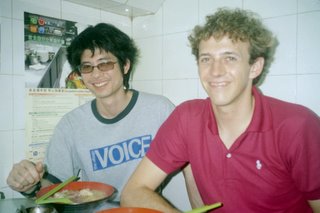10/20: the knock-off dynasty
 Ryan was MIA this morning, so B and Jon and I hit Hollywood Road, where all the antiques are. Jon is the guy to go with, as he knows the difference between the Han and Tang and Qing and Ming dynasties, between real and fake. We saw fat ceramic pots dripping with emerald green glaze, little armless soldiers, asymmetrical shelves, slotted benches. A lot of it was gorgeous, but some of it—even some of the gorgeous pieces—looked a little bit like something you’d find in a model home. The big, pale stone horse was supposed to guard a tomb, but he looked like he’d be equally comfortable guarding a sectional sofa. That’s the trouble with being a pomo kid, you don’t appreciate the real thing.
Ryan was MIA this morning, so B and Jon and I hit Hollywood Road, where all the antiques are. Jon is the guy to go with, as he knows the difference between the Han and Tang and Qing and Ming dynasties, between real and fake. We saw fat ceramic pots dripping with emerald green glaze, little armless soldiers, asymmetrical shelves, slotted benches. A lot of it was gorgeous, but some of it—even some of the gorgeous pieces—looked a little bit like something you’d find in a model home. The big, pale stone horse was supposed to guard a tomb, but he looked like he’d be equally comfortable guarding a sectional sofa. That’s the trouble with being a pomo kid, you don’t appreciate the real thing.We rode the string of escalators that run up the steep mountainside toward Victoria Peak. They pushed us up past noisy apartment buildings with peeling paint and clothes hanging out the windows on poles. Then all of a sudden we stepped off for a minute and we were at the mossy gates of a white mosque surrounded by villa-style apartments and a brick courtyard, and everything felt quiet and ancient. Even though a plaque said the mosque was rebuilt in 1915, it still felt ancient.
I can’t even begin to wrap my head around how old China really is. Around what it would be like to be a farmer who stumbles across a tomb while plowing his fields. Jon says that happens all the time.
Jon is very chill with a low, lazy laugh. If you ask him a question, he’s fond of saying, “I have no idea.” He’s always up for “whatever.” He’s a good addition to our group, since there is not one square inch of Asia that Ryan and B do not have opinions about. Also, because he’s Chinese-American, people frequently think he’s our guide and offer to give him free stuff.
We met up with Ryan and took a cruise on an authentic junk (well, authentic if you ignored the hum of the motor) to Kowloon, across the harbor from Hong Kong Island. The part of Hong Kong we’re staying in, called Center, I think, is all silver skyscrapers and air conditioned malls that sprawl across streets and underground. Kowloon is a little more Times Square, with tall and gritty buildings and neon signs trying to out-blink each other.
In a mall-like civic center, we stumbled onto a dance performance that was part of Hong Kong’s month-long Latin Passion Festival. The tap-salsa-ballroom-ish performance was immediately comforting to me. Something in my body just clicked, like my cells said, We get this. I don’t know if the Latin-ness reminded me of California or what. But I think it was more the Passion that spoke to me. It sounds cheesy, but I really feel like art is a universal language. Like the performer-audience relationship is a culture in itself.
After an overpriced happy hour and an underpriced noodle dinner, we hit the night market on Temple Street, where vendors set up booths in front of the closed storefronts and sell the same imported-from-China stuff you find in downtown LA, but for even less. I am a fan of cheap imported knock-offs and random goods—“silk” pajamas, “jade” jewelry, pig-shaped key chains with light-up noses, Che shirts, Mau shirts, and these gummy balls that flatten when you throw them against a wall—but I was feeling a little over-shopped at that point.



Comments